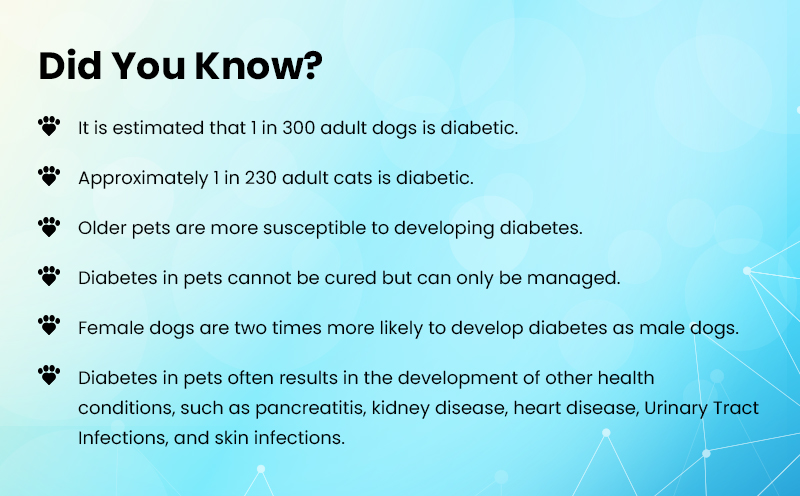Pet Diabetes Month – How to Care for Diabetic Pet

Like humans, pets are also prone to developing diabetes. The condition is common in middle-aged cats and dogs. However, it is hard to identify if your pet has diabetes, as there is a lack of knowledge and awareness among pet parents about the symptoms and risks of this condition.
This is why, every year, November is dedicated to educating pet parents on how to protect and care for their diabetic pets. By raising awareness, we can save our pets from the troubles and inconveniences caused by diabetes.
History of Pet Diabetes Month
Pet Diabetes Month was initiated by the British Veterinary Association (BVA) and the British Small Animal Veterinary Association (BSAVA) in 2005.
In this article, we will thoroughly discuss diabetes in pets and how you can care for your diabetic pet.

Understanding Diabetes in Pets
Diabetes, or diabetes mellitus, in pets, is a medical condition that occurs when the body cannot properly utilize glucose. The blood glucose levels of your pets are primarily controlled and regulated by the hormone insulin. When pets suffer from diabetes, either their body doesn’t produce enough insulin or their cells become resistant to its effects. This leads to high blood sugar levels in pets, causing a wide range of symptoms and health problems if left untreated.
[Also Read] November is National Pet Cancer Awareness Month
Signs and Symptoms of Diabetes in Pets
Symptoms of diabetes in pets are often mild and easily mistaken for other conditions leading to the development of the condition. Here are a few signs that may indicate diabetes:
- Increased thirst and urination
- Weight loss despite increased appetite
- Lethargy
- Frequent urinary tract infections
- Sweet or fruity odor to their breath
- Cataract in dogs
- Abnormal gait in cats
If you notice any of these symptoms in your pet, it is important to consult a veterinarian for proper diagnosis and treatment.
Risks Associated with Diabetes in Pets
The most common risks associated with diabetes in pets include:
- Kidney Disease: Diabetic nephropathy is a common complication of diabetes in pets. High blood sugar levels lead to kidney damage over time and if left untreated, results in kidney failure.
- Eye Disease: Diabetic retinopathy is another common complication of diabetes in which the retina is damaged. This may further lead to blindness.
- Diabetic Cataract: Diabetic Cataract affects both eyes of the pet. The condition develops when high glucose levels in the blood are converted into sorbitol, a sugar that can’t pass through the lens capsule. This leads to the accumulation of sugar on the lens, causing blurred vision in pets.
Taking Care of Diabetic Pets
It is important to closely work with your veterinarian to manage the diabetes without any complications. Your pet can still live a long, healthy life with appropriate care and precautions.
Here are a few tips to follow to manage diabetes in your pet:
- Manage Diet: The most important aspect of managing diabetes in pets is to manage their diet by including good-quality protein, fiber, and carbohydrates in their food.
- Exercise: Exercise helps avoid sudden spikes in blood glucose levels and maintain a healthy weight, which is important for diabetic pets.
- Treatment: Diabetic pets in the later stages of their condition may require treatment. This particularly includes insulin shots. Your veterinarian will give you an effective line of treatment for your diabetic pet.
- Supplements: Your vet may advise you to use some health supplements including supplements for urinary incontinence to manage their polyurea, for joint health to manage joint pain related to obesity, and other supplements to provide comfort and support to pets.
- Monitor Blood Glucose Levels: Monitoring the blood sugar levels of your pet allows you to peek into the effectiveness of the prescribed treatment plan. By doing so, you can effectively prevent the progression of the disease and make necessary adjustments to their care routine.
- Frequent Check-ups: Lastly, it is important to consult your vet and have regular examinations and tests performed by the vet. The vet can further help you make adjustments to the treatment plan and effectively manage the disease.
[Also Read] Newly Launched Dorwest Herbal Pet Care Products
Wrap Up – November is Pet Diabetes Month
Diabetes is a serious health issue for pets, but it can be managed with proper treatment and care. This Pet Diabetes Month, you can learn more about this disease and how you can support your pets in their tough times. With a proper diet, exercise, treatments, and supplements, you can effectively maintain the overall health of your pet. Consult with your vet to find the best treatment plan for your pet.

David joined CanadaVetCare in 2013 as a product analyst and veterinary assistant. Being a passionate pet lover and keen animal health researcher, David had always found ways and solutions to help pet parents to improve their pets’ health. He is always happy to answer pet health-related queries and recommending pet parents for the right pet product for their furry companions.

